Higher classification Chickory | Tribe Cichorieae Scientific name Cichorium intybus Rank Species | |
 | ||
Similar Endive, Radicchio, Common Dandelion, Chard, Fennel | ||
Wild edibles chicory
Common chicory, Cichorium intybus, is a somewhat woody, perennial herbaceous plant of the dandelion family Asteraceae, usually with bright blue flowers, rarely white or pink. Many varieties are cultivated for salad leaves, chicons (blanched buds), or roots (var. sativum), which are baked, ground, and used as a coffee substitute and additive. It is also grown as a forage crop for livestock. It lives as a wild plant on roadsides in its native Europe, and is now common in North America, China, and Australia, where it has become widely naturalized. "Chicory" is also the common name in the United States for curly endive (Cichorium endivia); these two closely related species are often confused.
Contents
- Wild edibles chicory
- Chicory wild edibles series
- Names
- Description
- Wild
- Cultivated
- Root chicory
- Agents responsible for bitterness
- Medicinal use
- Alternative medicine
- Native American use
- Forage
- Forage chicory varieties
- History
- Invasive
- References
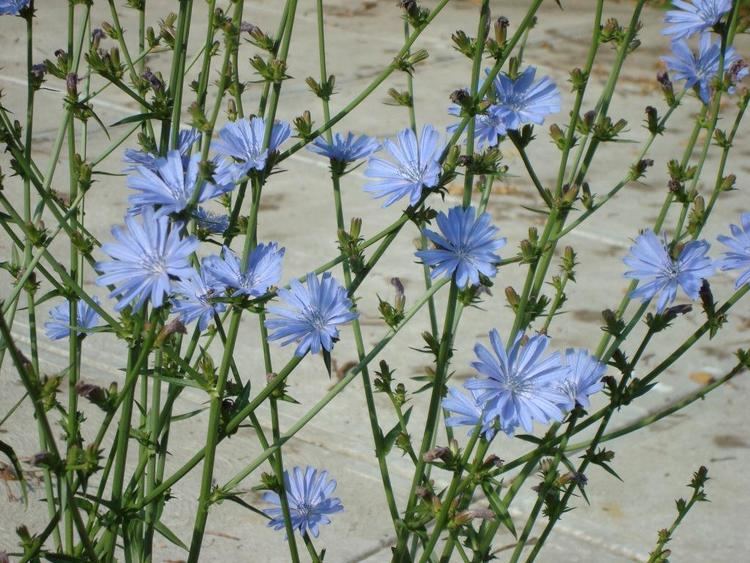
Chicory wild edibles series
Names
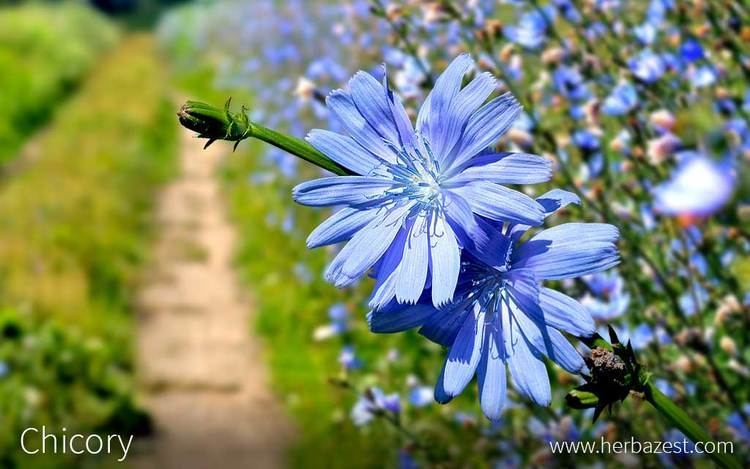
Common chicory is also known as blue daisy, blue dandelion, blue sailors, blue weed, bunk, coffeeweed, cornflower, hendibeh, horseweed, ragged sailors, succory, wild bachelor's buttons, and wild endive. (Note: "Cornflower" is commonly applied to Centaurea cyanus.) Common names for varieties of var. foliosum include endive, radicchio, radichetta, Belgian endive, French endive, red endive, sugarloaf, and witloof (or witlof).
Description
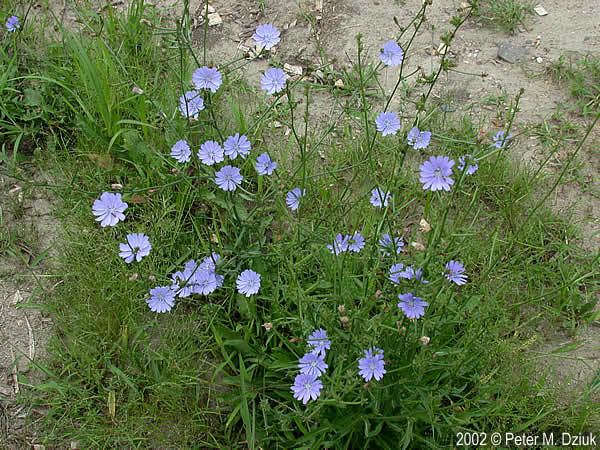
When flowering, chicory has a tough, grooved, and more or less hairy stem, from 30 to 100 cm (10 to 40 in) tall. The leaves are stalked, lanceolate and unlobed. The flower heads are 2 to 4 cm (0.79 to 1.6 in) wide, and usually bright blue, rarely white or pink. Of the two rows of involucral bracts, the inner is longer and erect, the outer is shorter and spreading. It flowers from July until October. The achenes have no pappus (feathery hairs), but do have toothed scales on top.
Wild
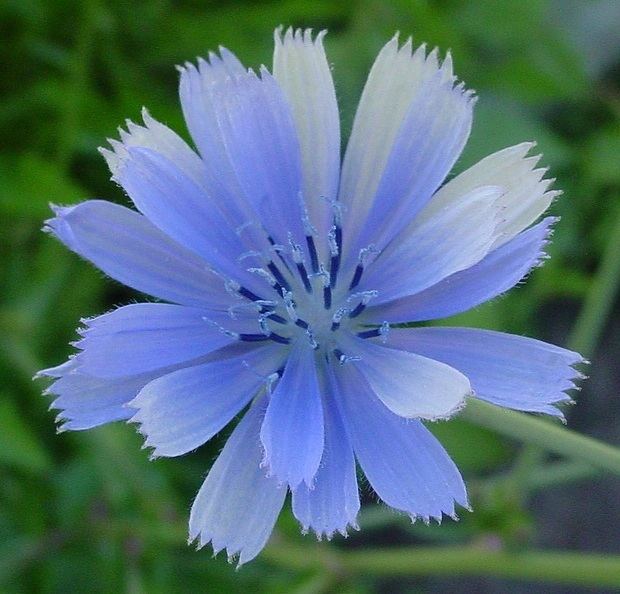
Wild chicory leaves usually have a bitter taste. Their bitterness is appreciated in certain cuisines, such as in the Ligurian and Apulian regions of Italy and also in southern part of India along with coffee, in Catalonia, Greece, and Turkey. In Ligurian cuisine, wild chicory leaves are an ingredient of preboggion and in Greek cuisine of horta; in the Apulian region, wild chicory leaves are combined with fava bean puree in the traditional local dish fave e cicorie selvatiche. in Albania, the leaves are used as a spinach substitute, mainly served simmered and marinated in olive oil, or as ingredient for fillings of byrek.
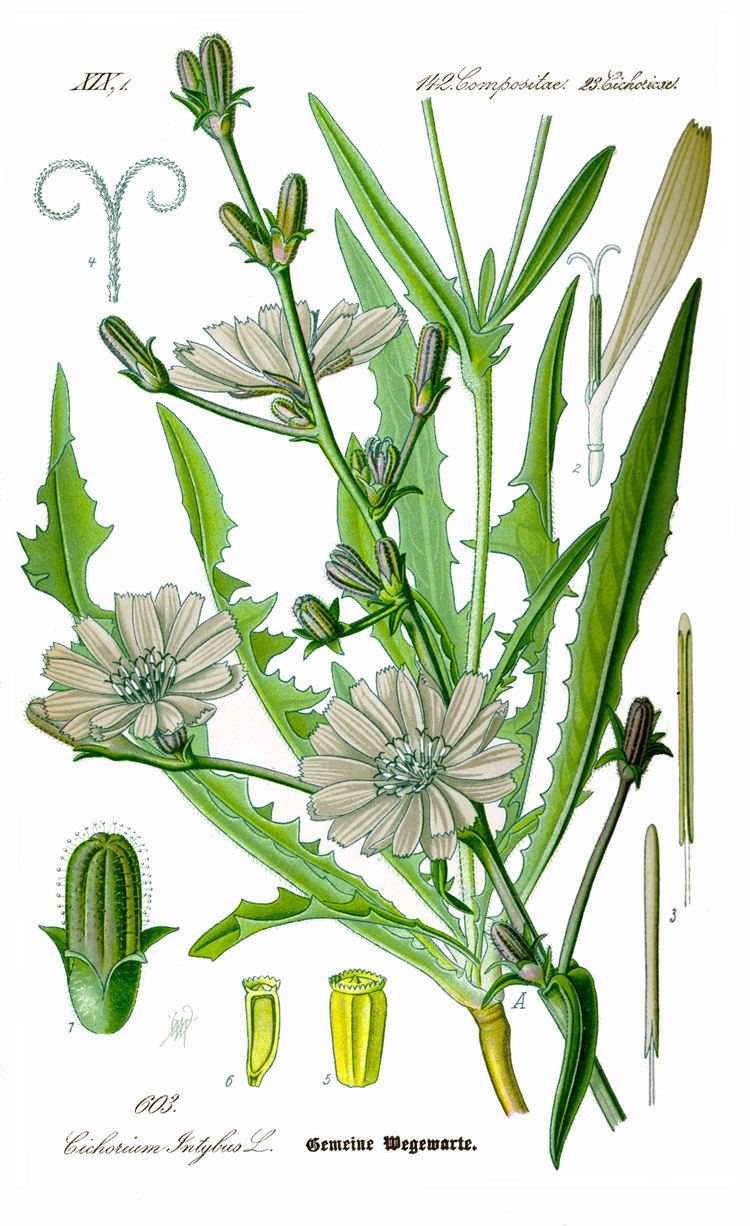
By cooking and discarding the water, the bitterness is reduced, after which the chicory leaves may be sautéed with garlic, anchovies, and other ingredients. In this form, the resulting greens might be combined with pasta or accompany meat dishes.
Cultivated

Chicory may be cultivated for its leaves, usually eaten raw as salad leaves. Cultivated chicory is generally divided into three types, of which there are many varieties:
The Catalogna chicory (also known as puntarelle) includes a whole subfamily (some varieties from Belgian endive and some from radicchio) of chicory and used throughout Italy.
Although leaf chicory is often called "endive", true endive (Cichorium endivia) is a different species in the genus and should not be confused with Belgian endive.
Root chicory
Root chicory (Cichorium intybus var. sativum) has been cultivated in Europe as a coffee substitute. The roots are baked, roasted, ground, and used as an additive, especially in the Mediterranean region (where the plant is native). As a coffee additive, it is also mixed in Indian filter coffee, and in parts of Southeast Asia, South Africa, and southern United States, particularly in New Orleans. It has been more widely used during economic crises such as the Great Depression in the 1930s and during World War II in Continental Europe. Chicory, with sugar beet and rye, was used as an ingredient of the East German Mischkaffee (mixed coffee), introduced during the "East German coffee crisis" of 1976-79.
Some beer brewers use roasted chicory to add flavor to stouts (commonly expected to have a coffee-like flavour). Others have added it to strong blond Belgian-style ales, to augment the hops, making a witlofbier, from the Dutch name for the plant.
Around 1970, it was found that the root contains up to 20% inulin, a polysaccharide similar to starch. Inulin is mainly found in the plant family Asteraceae as a storage carbohydrate (for example Jerusalem artichoke, dahlia, yacon, etc.). It is used as a sweetener in the food industry with a sweetening power 1⁄10 that of sucrose and is sometimes added to yogurts as a prebiotic. Inulin is also gaining popularity as a source of soluble dietary fiber and functional food.
Chicory root extract is a dietary supplement or food additive produced by mixing dried, ground chicory root with water, and removing the insoluble fraction by filtration and centrifugation. Other methods may be used to remove pigments and sugars. It is used as a source of soluble fiber. Fresh chicory root typically contains, by dry weight, 68% inulin, 14% sucrose, 5% cellulose, 6% protein, 4% ash, and 3% other compounds. Dried chicory root extract contains, by weight, about 98% inulin and 2% other compounds. Fresh chicory root may contain between 13 and 23% inulin, by total weight.
Agents responsible for bitterness
The bitter substances are primarily the two sesquiterpene lactones lactucin and lactucopicrin. Other ingredients are aesculetin, aesculin, cichoriin, umbelliferone, scopoletin, 6,7-dihydrocoumarin, and further sesquiterpene lactones and their glycosides.
Medicinal use
Root chicory contains volatile oils similar to those found in plants in the related genus Tanacetum which includes Tansy, and is similarly effective at eliminating intestinal worms. All parts of the plant contain these volatile oils, with the majority of the toxic components concentrated in the plant's root.
Chicory is well known for its toxicity to internal parasites. Studies indicate that ingestion of chicory by farm animals results in reduction of worm burdens, which has prompted its widespread use as a forage supplement. Only a few major companies are active in research, development, and production of chicory varieties and selections, most in New Zealand.
Chicory (especially the flower), used as a folk medicine in Germany, is recorded in many books as an ancient German treatment for everyday ailments. It is variously used as a tonic and as a treatment for gallstones, gastro-enteritis, sinus problems and cuts and bruises. (Howard M. 1987). Chicory contains inulin, which may help humans with weight loss, constipation, improving bowel function and general health. In rats, it may increase calcium absorption and bone mineral density. It also increases absorption of calcium and other minerals in humans.
Chicory has demonstrated antihepatotoxic potential in animal studies.
Alternative medicine
Chicory has been listed as one of the 38 plants that are used to prepare Bach flower remedies, a kind of alternative medicine. However, according to Cancer Research UK, "there is no scientific evidence to prove that flower remedies can control, cure or prevent any type of disease, including cancer".
Native American use
The Cherokee use an infusion of the root as a tonic for nerves. The Iroquois use a decoction of the roots as a wash and apply a poultice of it to chancres and fever sores.
Forage
Chicory is highly digestible for ruminants and has a low fiber concentration. Chicory roots are an "excellent substitute for oats" for horses due to their protein and fat content. Chicory contains a low quantity of reduced tannins that may increase protein utilization efficiency in ruminants. Some tannins reduce intestinal parasites. (Excessively large quantities of tannins, however, could bind with and precipitate proteins, resulting in low digestibility and nutrient reduction.)
Although chicory might have originated in France, Italy, and India, much development of chicory for use with livestock has taken place in New Zealand.
Forage chicory varieties
History
The chicory plant is one of the earliest cited in recorded literature. Horace mentions it in reference to his own diet, which he describes as very simple: "Me pascunt olivae, me cichorea, me malvae" ("As for me, olives, endives, and mallows provide sustenance"). In 1766, Frederick the Great banned the importation of coffee into Prussia leading to the development of a coffee-substitute by Brunswick innkeeper Christian Gottlieb Förster (died 1801), who gained a concession in 1769/70 to manufacture it in Brunswick and Berlin. By 1795 there were 22 to 24 factories of this type in Brunswick. Lord Monboddo describes the plant in 1779 as the "chicoree", which the French cultivated as a pot herb. In Napoleonic Era France, chicory frequently appeared as either an adulterant in coffee, or as a coffee substitute. Chicory was also adopted as a coffee substitute by Confederate soldiers during the American Civil War, and has become common in the United States. It was also used in the United Kingdom during the Second World War, where Camp Coffee, a coffee and chicory essence, has been on sale since 1885.
The cultivated chicory plant has a history reaching back to ancient Egyptian time. Medieval monks raised the plants and when coffee was introduced to Europe, the Dutch thought that chicory made a lively addition to the bean drink.
In the United States chicory root has long been used as a substitute for coffee in prisons. By the 1840s, the port of New Orleans was the second largest importer of coffee (after New York). Louisianans began to add chicory root to their coffee when Union naval blockades during the American Civil War cut off the port of New Orleans, thereby creating a long-standing tradition.
A common meal in Rome, puntarelle, is made with chicory sprouts. The United Nations Food and Agriculture Organization (FAO) reports that Chicory is a native plant of western Asia, North Africa and Europe.
Chicory is also mentioned in certain sericulture (silk-growing) texts. It is said that the primary caretaker of the silkworms, the "silkworm mother", should not eat or even touch it.
The chicory flower is often seen as inspiration for the Romantic concept of the Blue Flower (e. g. in German language 'Blauwarte' ≈ 'blue lookout by the wayside'). It could open locked doors, according to European folklore.
Invasive
Cichorium intybus has been declared an invasive species in several states in the USA.
